间接言语行为理论
- 格式:ppt
- 大小:402.00 KB
- 文档页数:12
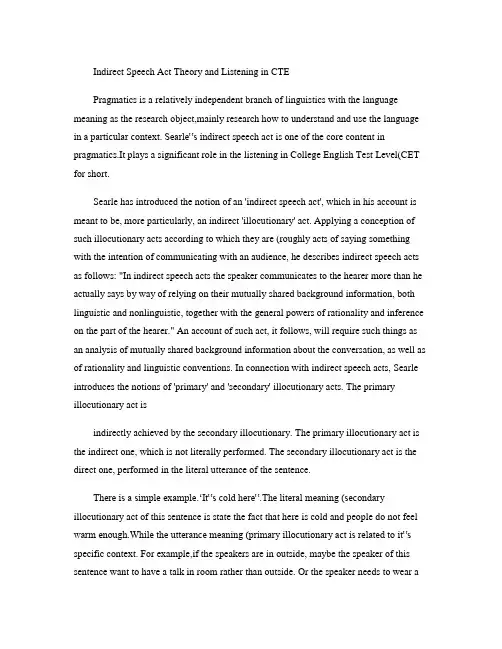
Indirect Speech Act Theory and Listening in CTEPragmatics is a relatively independent branch of linguistics with the language meaning as the research object,mainly research how to understand and use the language in a particular context. Searle‟s indirect speech act is one of the core content in pragmatics.It plays a significant role in the listening in College English Test Level(CET for short.Searle has introduced the notion of an 'indirect speech act', which in his account is meant to be, more particularly, an indirect 'illocutionary' act. Applying a conception of such illocutionary acts according to which they are (roughly acts of saying something with the intention of communicating with an audience, he describes indirect speech acts as follows: "In indirect speech acts the speaker communicates to the hearer more than he actually says by way of relying on their mutually shared background information, both linguistic and nonlinguistic, together with the general powers of rationality and inference on the part of the hearer." An account of such act, it follows, will require such things as an analysis of mutually shared background information about the conversation, as well as of rationality and linguistic conventions. In connection with indirect speech acts, Searle introduces the notions of 'primary' and 'secondary' illocutionary acts. The primary illocutionary act isindirectly achieved by the secondary illocutionary. The primary illocutionary act is the indirect one, which is not literally performed. The secondary illocutionary act is the direct one, performed in the literal utterance of the sentence.There is a simple example.‘It‟s cold here‟.The literal meaning (secondary illocutionary act of this sentence is state the fact that here is cold and people do not feel warm enough.While the utterance meaning (primary illocutionary act is related to it‟s specific context. For example,if the speakers are in outside, maybe the speaker of this sentence want to have a talk in room rather than outside. Or the speaker needs to wear amore coat or the speaker caught a cold. If the speakers are in the room, the utterance meaning of the sentence maybe to have others closed the window. The request is indirectly achieved by …statement‟. Thus it can be seen that the illocution ary of speech is varied according to its context. It is important to hearers to grasp related background of context and have reasoning ability in order to understand indirect speech act correctly. Because the process of listening comprehension is a complex information processing rather than collect and decoding Language unit simply. Therefore, in order to improving students‟ listening comprehension, students should learn how to use language accurately and reinforce their understanding of indirect speech act. Only in this way canlisteners based on the literal meaning reasoning the utterance meaning to ensure smooth communication.The ultimate goal of CET is to measure the college students' comprehensive application ability more accurately. The part of listening occupied approximate 35% in CET. The largest proportion of it is to understand the important or specific details and reasoning. For example(January 2003,CET-4,No.3:W:John,what are you doing on your computer? Don‟t you remember your promise?M:This is not a game. It‟s only a crossword puzzle that helps increase my vocabulary.Q:What is the probable relationship between the speakers?AColleagues.BHusband and wife.CEmployer and employee.DMother and son.From the above example,W thought that M is playing computer games again and wanted to stop M, while M responded that …This is not a game. It‟s only a crossword puzzle that helps increase my vocabulary.‟ Thus it can be seen that W‟s thought was not the fact. The literal meaning of W is to “inquiry”( what are you doing on your computer? Don‟t you remember your promise?,while the utterance meaning is “blame”. The primary illocutionary act(blame is achieved by the secondary illocutionary(inquiry. From the two speakers conversation, first we can know W‟s stat us is higher than M, W is in education, discipline position while M is to be taught. Then the speakers used the informal language, it indicated that they have a close relationship. We can learn it most likely is the dialogue between parents and children. So ,the answer is D Mother and son.Another example(January 2003,CET-4,No.9W: Listen to me, Joe, the exam is already a thing of the past. Just forget about it.M: That‟s easier said than done.Q: What can we infer from the conversation?AThe exam was easier than the previous one.BJoe is sure that he will do better in the next exam.CJoe probably failed in the exam.DThe oral part of the exam was easier than the written part.In this example, W said to M that “Joe, the exam is already a thing of the past. J ust forget about it.”M responded that “That‟s easier said than done.” Based on their conversation, M implied that thought the exam is already a thing of the past, but he still can't let go. From which we can infer that M‟s examination results are bad,may not even pass the exam. Therefore the correct answer is CJoe probably failed in the exam.Another more example(June 2012, CET-6M: A famous Russian ballet is coming to town next weekend. But I can‟t find a ticket anywhere.W: Don‟t be upset. My siste r just happened to have one and she can‟t go since she has got some sort of conflict in her schedule.Q: What does the woman mean?A Her sister will come to watch ballet performance.B Her sister also want a ticket.C She can get a ballet ticket for the man.D She will come to watch ballet performance with the man.In this example, M said that there will a famous Russian ballet is coming, but he can‟t find a ticket anywhere. This indicate that he want to have a ticket to watch ballet performance but have no one ticket. W‟s answer imply her sister has one ticket but she can‟t go since she has other more important things to do. So the correct answer is C She can get a ballet ticket for the man.In our daily communication activity, communication subjects are between in the interactive relationship. To speaker, communication is a kind of express behavior guaranteed to get association ; To hearer, communication is a process of recognizespeakers' intention, reasoning, and reading the words information. Only accurately understanding the implication of discourse, can we be fully understanding discoursemeaning and communication successfully. So does listening in College English Test Level. Thus it can be seen that introduce the indirect speech act theory into listening can help students to improve the ability to understand the speech ultimately. Therefore, students should learn make detailed analysis of all kinds of indirect speech act examples and to understand language from the point of view of the text. Moreover, they also should observe and sum up the indirect speech act in the daily life and learn how to use it correctly in communicative activities.。
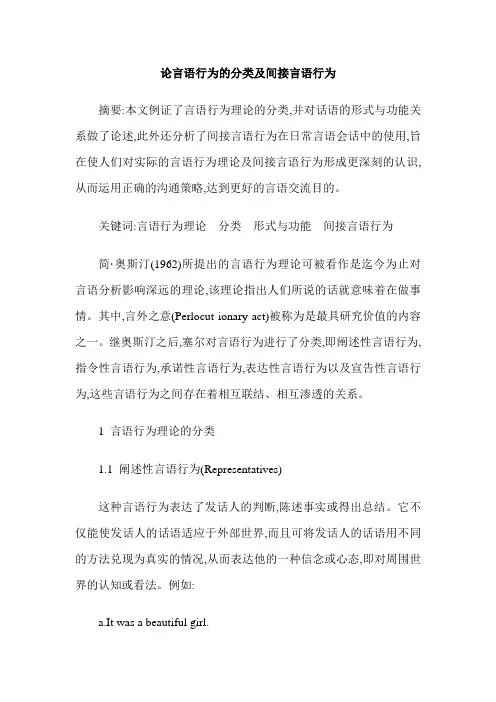
论言语行为的分类及间接言语行为摘要:本文例证了言语行为理论的分类,并对话语的形式与功能关系做了论述,此外还分析了间接言语行为在日常言语会话中的使用,旨在使人们对实际的言语行为理论及间接言语行为形成更深刻的认识,从而运用正确的沟通策略,达到更好的言语交流目的。
关键词:言语行为理论分类形式与功能间接言语行为简·奥斯汀(1962)所提出的言语行为理论可被看作是迄今为止对言语分析影响深远的理论,该理论指出人们所说的话就意味着在做事情。
其中,言外之意(Perlocut ionary act)被称为是最具研究价值的内容之一。
继奥斯汀之后,塞尔对言语行为进行了分类,即阐述性言语行为,指令性言语行为,承诺性言语行为,表达性言语行为以及宣告性言语行为,这些言语行为之间存在着相互联结、相互渗透的关系。
1 言语行为理论的分类1.1 阐述性言语行为(Representatives)这种言语行为表达了发话人的判断,陈述事实或得出总结。
它不仅能使发话人的话语适应于外部世界,而且可将发话人的话语用不同的方法兑现为真实的情况,从而表达他的一种信念或心态,即对周围世界的认知或看法。
例如:a.It was a beautiful girl.b.John didn’t like music.1.2 指令性言语行为(Directives)在指令性言语行为中,发话人会使用这种言语行为去促使听话人做某件事情。
它可以表达出发话人真实所想,可以是命令,请求、乞求、建议等。
在这种言语行为下,发话人试图通过听话人使外部世界更好地适应于他所表达的话语,表达出使听话人具体去做某事的主观愿望。
例如:a.Give me a glass of milk.b.Could you help me, please?1.3 承诺性言语行为(Commissives)这种言语行为表达对未来的事情或活动做出承诺。
它可以表达出发话人的真实目的,可以是承诺,威胁,拒绝,发誓等,它由发话人自己发出信息,试图通过所说的话语使外部世界适应于自己的言语。
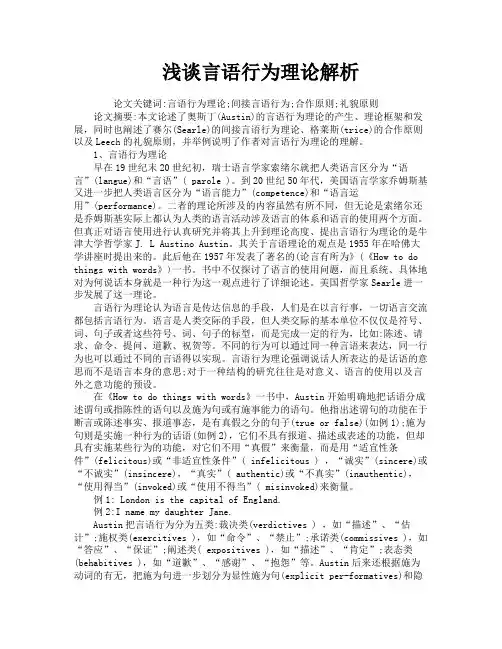
浅谈言语行为理论解析论文关键词:言语行为理论;间接言语行为;合作原则;礼貌原则论文摘要:本文论述了奥斯丁(Austin)的言语行为理论的产生、理论框架和发展,同时也阐述了赛尔(Searle)的间接言语行为理论、格莱斯(trice)的合作原则以及Leech的礼貌原则,并举例说明了作者对言语行为理论的理解。
1、言语行为理论早在19世纪末20世纪初,瑞士语言学家索绪尔就把人类语言区分为“语言”(langue)和“言语”( parole )。
到20世纪50年代,美国语言学家乔姆斯基又进一步把人类语言区分为“语言能力”(competence)和“语言运用”(performance)。
二者的理论所涉及的内容虽然有所不同,但无论是索绪尔还是乔姆斯基实际上都认为人类的语言活动涉及语言的体系和语言的使用两个方面。
但真正对语言使用进行认真研究并将其上升到理论高度、提出言语行为理论的是牛津大学哲学家J. L Austino Austin。
其关于言语理论的观点是1955年在哈佛大学讲座时提出来的。
此后他在1957年发表了著名的(论言有所为》(《How to do things with words》)一书。
书中不仅探讨了语言的使用问题,而且系统、具体地对为何说话本身就是一种行为这一观点进行了详细论述。
美国哲学家Searle进一步发展了这一理论。
言语行为理论认为语言是传达信息的手段,人们是在以言行事,一切语言交流都包括言语行为。
语言是人类交际的手段,但人类交际的基本单位不仅仅是符号、词、句子或者这些符号、词、句子的标型,而是完成一定的行为,比如:陈述、请求、命令、提问、道歉、祝贺等。
不同的行为可以通过同一种言语来表达,同一行为也可以通过不同的言语得以实现。
言语行为理论强调说话人所表达的是话语的意思而不是语言本身的意思;对于一种结构的研究往往是对意义、语言的使用以及言外之意功能的预设。
在《How to do things with words》一书中,Austin开始明确地把话语分成述谓句或指陈性的语句以及施为句或有施事能力的语句。
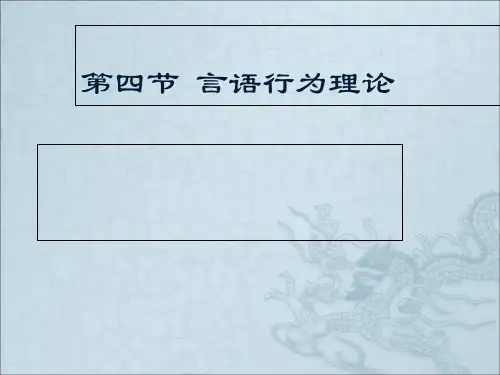
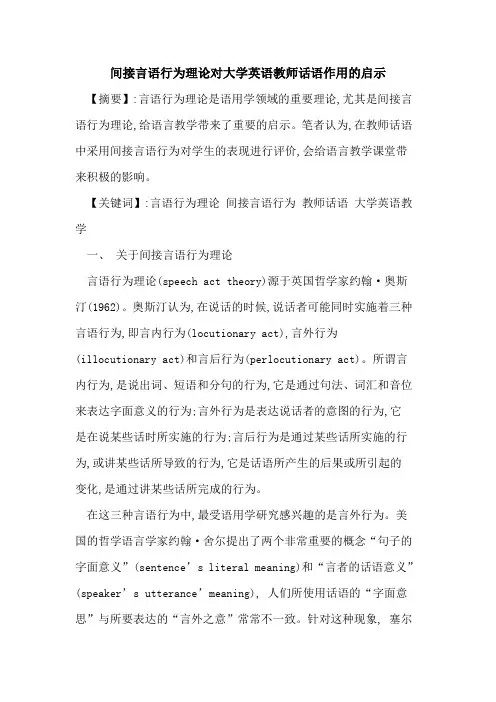
间接言语行为理论对大学英语教师话语作用的启示【摘要】:言语行为理论是语用学领域的重要理论,尤其是间接言语行为理论,给语言教学带来了重要的启示。
笔者认为,在教师话语中采用间接言语行为对学生的表现进行评价,会给语言教学课堂带来积极的影响。
【关键词】:言语行为理论间接言语行为教师话语大学英语教学一、关于间接言语行为理论言语行为理论(speech act theory)源于英国哲学家约翰·奥斯汀(1962)。
奥斯汀认为,在说话的时候,说话者可能同时实施着三种言语行为,即言内行为(locutionary act),言外行为(illocutionary act)和言后行为(perlocutionary act)。
所谓言内行为,是说出词、短语和分句的行为,它是通过句法、词汇和音位来表达字面意义的行为;言外行为是表达说话者的意图的行为,它是在说某些话时所实施的行为;言后行为是通过某些话所实施的行为,或讲某些话所导致的行为,它是话语所产生的后果或所引起的变化,是通过讲某些话所完成的行为。
在这三种言语行为中,最受语用学研究感兴趣的是言外行为。
美国的哲学语言学家约翰·舍尔提出了两个非常重要的概念“句子的字面意义”(sentence’s literal meaning)和“言者的话语意义”(speaker’s utterance’meaning), 人们所使用话语的“字面意思”与所要表达的“言外之意”常常不一致。
针对这种现象, 塞尔在修正奥斯汀言语行为理论的基础上, 围绕着二者之间的区别与联系区分了直接言语行为(direct speech acts)和间接言语行为(indirect speech acts)。
直接言语行为是指言者说出某话并字面上意指他所说的话。
间接言语行为是指言者说出一个既意指他所说的, 又意指更多的东西的话。
通过对间接言语行为的研究, 塞尔分析了话语意义和句子字面意义不完全一致的情况, 指出在间接言语行为中, 特别要注意发现说话者的话语意义, 话语意义是随着语境的不同而不断发生变化的。
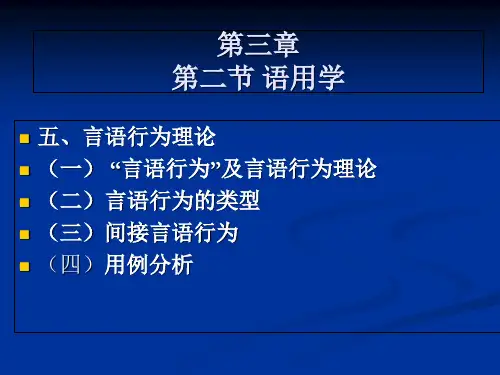

试论通过言语行为理论透析奥斯汀和塞尔的语言哲学观〔论文关键词」言语行为理论间接言语行为理论语言哲学〔论文摘要」20世纪初,西方传统哲学发生了一次根本性的“语言转向”,语言取代认识论成为哲学研究的中心课题。
1962年英国哲学家奥斯汀提出了“言语行为理论”这一概念,此后,美国哲学家塞尔提出了着名的“间接言语行为理论”,修正和完善了奥斯汀的言语行为理论,为我们在新时期全面理解语言的现象和本质提供了一个全新的视域。
言语行为理论(speech act theory)首先是由英国牛津大学的哲学家奥斯汀((j. l. austin)1962年在他的着名哲学着作《论如何以言行事》里提出来的。
言语行为理论的基本出发点是:人类语言交际的基本单位不应是词、句子或其他语言形式,而应是人们用词或句子所完成的行为(austin, 1962)。
奥斯汀把注意力集中在语言的使用上,把语言的使用视为一种行为,抓住了语言的动态特征,开拓了从行为的角度来研究语言的使用这条道路。
塞尔((j. r. searle)是奥斯汀的学生,他同意奥斯汀的观点,即语言交流的最小单位不是符号、词或句子,而是被完成了的某种言语行为。
不过,他对“言语行为本身夕,与“用以完成言语行为而说出的话语”这两个概念进行了区分,认为两者不是完全对等的关系,不能混为一谈。
塞尔系统地发展了奥斯汀的言语行为思想,阐述了言语行为的原则和分类标准,提出了间接言语行为理论这一特殊的言语行为类型。
奥斯汀和塞尔都是语言哲学家,他们对语言的研究都是在哲学轨道上进行的。
“言语行为理论”的提出改变了人们对语言本质的认识,为我们全面理解语言的现象和本质提供了一条新的思路口一、奥斯汀对言语行为理论的贡献言语行为理论认为,从根本意义上来说,话语是一种行为,它不仅包含“言有所述”,而且包含“言有所为”,甚至涉及“言后之果”(austin, 1962) o言语行为理论的创始人是英国的语言哲学家奥斯汀。
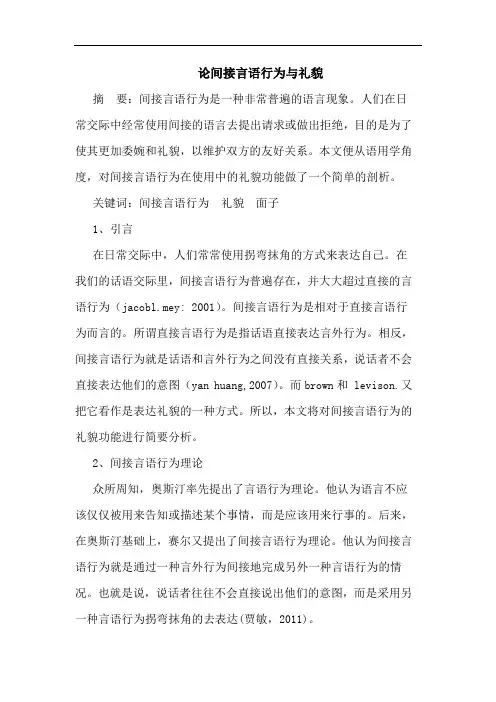
论间接言语行为与礼貌摘要:间接言语行为是一种非常普遍的语言现象。
人们在日常交际中经常使用间接的语言去提出请求或做出拒绝,目的是为了使其更加委婉和礼貌,以维护双方的友好关系。
本文便从语用学角度,对间接言语行为在使用中的礼貌功能做了一个简单的剖析。
关键词:间接言语行为礼貌面子1、引言在日常交际中,人们常常使用拐弯抹角的方式来表达自己。
在我们的话语交际里,间接言语行为普遍存在,并大大超过直接的言语行为(jacobl.mey: 2001)。
间接言语行为是相对于直接言语行为而言的。
所谓直接言语行为是指话语直接表达言外行为。
相反,间接言语行为就是话语和言外行为之间没有直接关系,说话者不会直接表达他们的意图(yan huang,2007)。
而brown和 levison.又把它看作是表达礼貌的一种方式。
所以,本文将对间接言语行为的礼貌功能进行简要分析。
2、间接言语行为理论众所周知,奥斯汀率先提出了言语行为理论。
他认为语言不应该仅仅被用来告知或描述某个事情,而是应该用来行事的。
后来,在奥斯汀基础上,赛尔又提出了间接言语行为理论。
他认为间接言语行为就是通过一种言外行为间接地完成另外一种言语行为的情况。
也就是说,说话者往往不会直接说出他们的意图,而是采用另一种言语行为拐弯抹角的去表达(贾敏,2011)。
总体来讲,间接言语行为可分为两类,即规约性间接言语行为和非规约性间接言语行为。
相对而言,前者理解起来比后者更容易,因为它完全可以从形式或者字面意思上理解。
而后者必须依赖语境,需要依靠双方的共有知识和所处的语言环境进行推理。
所以,从某种程度上讲,非规约性言语行为比规约性更间接。
3、间接言语行为的礼貌功能间接言语行为被广泛地应用于我们的日常生活中,而且,间接言语的使用通常都是出于礼貌的目的(yan huang, 2007)。
由于人们之间的交际日益频繁,那么,在交际过程中注意礼貌就显得尤为重要。
在交际过程中注意礼貌,维护对方的面子,有利于使交际顺利的进行下去。
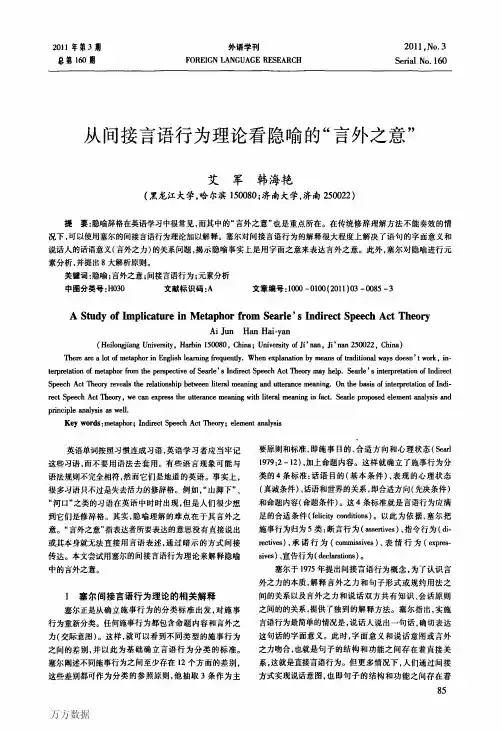

山东师大外国语学院学报2002第4期(总第13期) 简评二十世纪“间接言语行为”理论窦同沛 成方志摘要:间接言语行为是一种语用现象,它用一种言语行为的表达式来间接实现另一种言语行为。
二十世纪七十年代Searle著述对施为行为进行了划分,并对该理论进行了详细讨论。
该文对Searle等学者提出的间接言语行为理论从不同角度进行了论证,并提出离开语境就无法判断一个语句表达的是什么、只有推理理论才能妥善处理发话人从间接语句中得出意义的结论。
关键词:语用现象;间接言语行为;施为行为;语境;推论中图分类号:H0-06 文献标识码:A 文章编号:1009-2536(2002)04-0005-04 间接言语行为是指用一种言语行为的表达式来间接实现另一种言语行为的语用现象。
1969年Searle论述了“言语行为”理论,1975年他又著述详细讨论了“间接言语行为”理论。
Searle说言语行为可在三个方面不同:1.在使言语适合世界的方式方面不同———他说作为施为力点的一部分的某些施为句必须使言语(或严格来讲它们的命题内容)与世界相吻合,另一些则须使世界与言语相匹配。
断言属前一范畴,请求属后一范畴。
2.从表示的心理状态方面看不同———Searle用了believe,want和intent作为初始元素(primitives),并论证说,阐述或解释涉及“相信该命题”;承诺涉及“想要该命题”;命令涉及“需要该命题”。
3.从施为力点和目的方面看它们不同———这是三个中最关键的标准,与Searle以前分析中的承担义务条件相吻合。
利用这三个方面,Searle提出了施为行为的五个宏观类别(macro-classes):讲述性(representatives),指令性(directives),承诺性(commissives),表情性(ex-pressives)和宣告性(declarations)。
Searle对施为行为的划分使人们认识到解释基本行事话语的问题不像人们原来想象的那么大,但他确实没完全解决该问题。
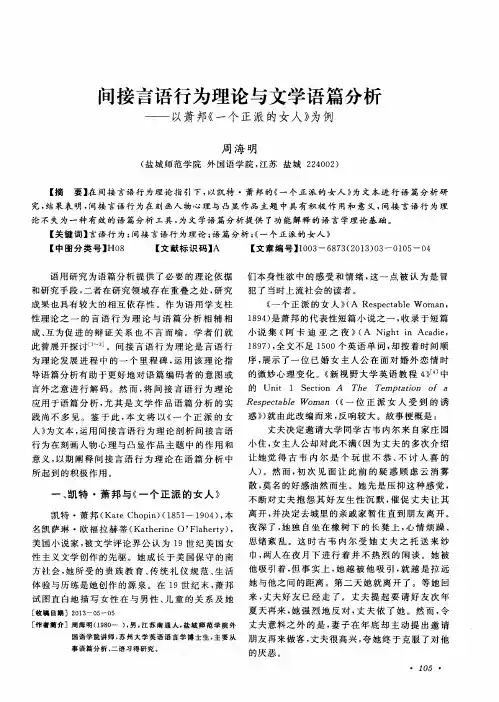
主持人话语中的间接言语行为研究间接言语行为理论是现代语言学中的重要理论。
目前,运用间接言语行为理论对主持人话语的分析实例较少。
在对其进行理论简释的基础上,说明这一理论在主持人话语分析中的价值,并尝试用这一理论对主持人话语进行分析。
标签:间接言语行为主持人话语言语行为理论由英国哲学家奥斯丁(J.L.Austin)正式提出,塞尔(John Searle)批判继承其理论,并进行了完善和深化。
根据言语行为理论,说话者说话时同时也在实施某种行为。
塞尔认为:言语行为根据其“语力”(illocutionary force),可分为5类:断言式(陈述、断定、描写、说明等)、指令式(请求、命令、建议、允许等)、承诺式(承诺、拒绝、威胁、发誓等)、表达式(感谢、祝贺、赞许、道歉等)、宣告式(宣告、宣布、任命等)。
在此基础上,塞尔进一步提出间接言语行为理论,即:一种以言行事行为通过另一种以言行事行为间接完成,表述意与语句意分离(实际意与字面意分离)。
塞尔在论述时,还将其进一步二分为“遵从惯例”的间接言语行为和非规约性间接言语行为。
前者的一个经典例子是说话人A通过“你能把盐递过来吗?”这样对B 的能力的询问,间接对听话人B提出指令。
而当说话人A邀约听话人B出去玩,B以“我得温习功课准备考试”间接拒绝了A的邀约时,这就构成了一个非规约性间接言语行为。
一、主持人间接言语行为研究的价值提到主持,首先要界定两个重要定义:主持,是指在广播、电视等传媒中,主持人和播音员以个体出现,代表媒体,用有声语言和副语言对节目传播进程的驾驭活动。
①节目主持艺术,是指节目主持人作为节目与观众的中介,以自身的学识及智慧为根基,通过语言(含体态语)驾驭节目进程,有效地实现传播目的的活动规律和创造性的方式方法。
②由此可推知:第一,主持人话语研究具有学科性,与之相关的播音与主持艺术、传播学、电视新闻学等是有学理研究基础和研究价值的。
第二,语言是主持艺术中最为重要的要素,对主持人话语的研究,不仅能扩充播音与主持研究的深度和广度,而且能对播音主持实践提供帮助和参考。
浅析言语行为理论摘要:20世纪初,西方哲学研究开始向语言转向,日常分析学派哲学家奥斯汀提出了言语行为理论,他学生对其对该理论进行了发展和修正,进一步提出了间接言语行为理论,引起了哲学界和语言学界的广泛关注。
本文综述言语行为理论的发展,并在此基础上进行简要的评述。
关键词:言语行为间接言语行为语言哲学一、引言在西方哲学史上,命题真假值问题一直困扰着哲学家。
20世纪初,在哲学的第三次转向中,语言取代了认识论成为哲学研究的中心课题,“语言转向”的产生,标志着英美分析哲学时代的开始。
哲学家对命题的研究从抽象的命题本身转向了用来表达命题的陈述句。
从使用的分析方法来看,分析哲学分为逻辑实证学派和日常语言学派。
前者主张建立科学语言以保证命题陈述的意义明晰化,后者则着眼于自然语言的分析。
逻辑实证主义者认为陈述句的作用是描述事物的状态或陈述某一事实,所做的描述或陈述必有真假,不能证明其真假的陈述无意义。
20世纪50年代末,英国哲学家austin针对逻辑实证主义的真值条件语义论提出言语行为理论。
在对陈述句进行研究时他发现,人们所说的许多话语貌似陈述,但它们根本不以记述或描述为目的,或仅是部分地以此为目的。
他注意到人说出话不仅是描写和陈述客观世界,而且也是一种行为。
他指出不少陈述虽无真假但确有意义,从而对逻辑实证主义的这一学说提出了异议。
austin根据陈述句不同的功能将其大致分为“表述句”(constatives)与“施为句”(performatives)两类。
他认为表述句和施为句的区别在于后者具有三个特点:1)主语必须是第一人称单数;2)谓语动词应该是施为动词;3)谓语动词的形式是肯定形式的现在时主动语态。
但是很快他又否定了这种标准形式。
例如“关上门”,这完全是施为句,但却不是直陈语气的第一人称现在时,也没有施为动词。
基于此,austin提出了显性施为句和隐形施为句。
只有前者才能明确显示出其完成的行为是什么,后者没有明确的施为动词,所实施的言语行为需要依靠语境来确定。
关于奥斯汀与塞尔的言语行为理论在人类的交际活动中,言语行为是最常见的一种交流方式,言语行为是指人们为了实现交际目的而在具体的语境中使用语言的行为。
下面是店铺带来的关于奥斯汀与塞尔的言语行为理论的内容,欢迎阅读参考!奥斯汀与塞尔的言语行为理论范文篇1:《试谈奥斯汀与塞尔的言语行为理论》马林诺夫斯基从人类学的角度,通过观察一个民族的文化生活和风俗习惯来研究语言的功能,认为与其把语言看成“思想的信号”,不如说它是“行为的方式”。
在语用学兴起后,这一术语得到了广泛的运用,言语行为被理解为人类实现目的的一种活动,构成人类总活动的有机组成部分。
人们的行为总要受到社会规约的支配,言语行为也就被看成受各种社会规约支配的一种行为。
英国哲学家奥斯汀(J.L.Aus一曲)于20世纪50年代提出“言语行为理论”(speechacttheory),后经塞尔(J.R.Searle)的完善和发展,成为哲学、语言学的重要研究课题,也成为现代语用学核心内容之一。
一、奥斯汀的言语行为理论言语行为理论是英国哲学家奥斯汀首先提出的。
1957年,他到美国哈佛大学去做讲座,以《以言行事》为书名发表了讲座的全部内容,在其论述中,贯穿了一个思想:人们说话的目的不仅仅是为说话,当他说一句话的同时可以实施一个行为。
言语行为理论的基本出发点是:人类语言交际的基本单位不应是词、句子或其他语言形式,而应是人们用词或句子所完成的行为。
奥斯汀认为,传统语法把句子按其功能分成陈述句、疑问句、祈使句等类型,这不利于人们对言语的理解和使用,因为同一句子在不同的语境中具有不同的功能。
他认为不少话语不仅是提供信息,而且是完成或帮助完成许多行为。
奥斯汀在此基础上提出了言语行为理论。
(一)表述句与施为句在《以言行事》中,奥斯汀首先区分了表述句(constative)和施为句(performative)。
很久以来,哲学家所持的一种假设是:陈述之言的作用或是描述事物的状态,或是陈述某一事实,两者必居其一,别无他用,而陈述之言所作的描述或陈述只能是真实或者是谬误。